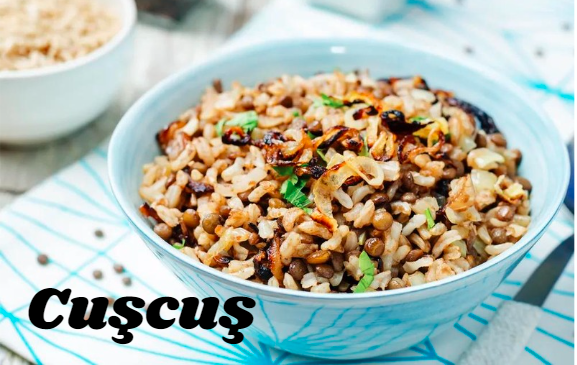Introduction to Cuşcuş
Cuşcuş, often spelled as couscous in English, is a time-honored dish originating from North Africa. It’s a staple in the diets of many regions and has transcended cultural boundaries to become a beloved dish worldwide. This tiny, granule-like pasta made from semolina wheat is celebrated for its versatility, nutritional value, and delightful taste. As a culinary icon, cuşcuş is more than just a meal; it’s a cultural emblem, a symbol of hospitality, and a versatile ingredient in numerous cuisines.
In this article, we will delve into the rich history, preparation methods, variations, nutritional benefits, and cultural significance of cuşcuş. We’ll also explore unique recipes and provide insights that go beyond what’s typically found in existing literature, offering a fresh perspective on this cherished dish.
The Origins and History of Cuşcuş
The Historical Roots
Cuşcuş has a rich history that dates back to the Berbers of North Africa, who were the first to make this dish. The Berbers, indigenous to the region, developed the technique of preparing and steaming semolina wheat to create cuşcuş. The name itself is derived from the Berber word “seksu,” which means well-rolled or rounded, referring to the shape of the grains.
The spread of cuşcuş across different cultures can be attributed to historical trade routes, conquests, and migrations. The dish traveled through the Mediterranean basin and into Europe during the Islamic conquests and later through the colonization period. Today, it is a staple in countries like Morocco, Algeria, Tunisia, and Libya, and has also found its place in Mediterranean and Middle Eastern cuisines.
Cultural Significance
In many North African countries, cuşcuş holds a special place in cultural and social traditions. It is often served during family gatherings, religious festivals, and other significant events. The preparation and sharing of cuşcuş are considered acts of hospitality and generosity. In some cultures, it is customary to serve cuşcuş on Fridays, which is a holy day in Islam, as a symbol of abundance and blessing.
How Cuşcuş is Made
Traditional Method
The traditional method of making cuşcuş involves a meticulous process of rolling and steaming. The primary ingredient is semolina wheat, which is mixed with water and rolled into small granules. These granules are then steamed in a special pot called a couscoussier, which has two compartments: the bottom for boiling water or stew and the top for steaming the cuşcuş. The steam from the boiling liquid cooks the cuşcuş, making it fluffy and light.
The process usually involves multiple rounds of steaming, with breaks in between to fluff the grains and sprinkle them with water. This ensures that each grain is evenly cooked and separated. The final product is often served with a rich stew of vegetables, meat, or fish, depending on regional and personal preferences.
Modern Variations
In modern times, the preparation of cuşcuş has become more convenient with the availability of instant cuşcuş. This version requires only a few minutes of steaming or soaking in hot water, making it an easy and quick option for busy households. Despite the convenience, traditionalists argue that instant cuşcuş lacks the texture and flavor of the hand-rolled and steamed variety.
Variations of Cuşcuş
Regional Variations
Cuşcuş is a versatile dish with numerous regional variations, each offering a unique twist on the classic recipe. Here are some notable variations:
- Moroccan Cuşcuş: Often served with a seven-vegetable stew, Moroccan cuşcuş is characterized by its aromatic spices like saffron, cinnamon, and ginger. It may also include dried fruits like raisins and apricots, adding a sweet dimension to the dish.
- Algerian Cuşcuş: In Algeria, cuşcuş is often accompanied by a tomato-based sauce called “marqa,” which includes vegetables and meat such as lamb or chicken. The dish may also feature chickpeas and a variety of spices.
- Tunisian Cuşcuş: Known for its spicy kick, Tunisian cuşcuş often incorporates harissa, a fiery chili paste. The dish is typically served with lamb, fish, or even merguez sausages, and is accompanied by vegetables like carrots, zucchini, and potatoes.
- Libyan Cuşcuş: In Libya, cuşcuş is commonly served with a tomato-based sauce and meat, often lamb or goat. It is less spiced compared to its Tunisian counterpart but still rich in flavor.
International Adaptations
As cuşcuş has gained popularity worldwide, chefs and home cooks have adapted the dish to suit various culinary styles and dietary needs. For instance, in Mediterranean cuisines, cuşcuş is often used as a base for salads, mixed with fresh vegetables, herbs, and a light vinaigrette. In Western kitchens, cuşcuş has also been incorporated into fusion dishes, combining elements from different culinary traditions.
Nutritional Benefits of Cuşcuş
Nutrient Profile
Cuşcuş is not only delicious but also packed with nutrients. It is a good source of complex carbohydrates, providing energy and sustenance. A standard serving of cuşcuş contains about 150 calories, 30 grams of carbohydrates, and 6 grams of protein. It is also low in fat and cholesterol, making it a heart-healthy option.
Rich in Fiber
Whole grain cuşcuş is particularly high in dietary fiber, which aids in digestion and helps maintain a healthy gut. Fiber also contributes to a feeling of fullness, making cuşcuş a satisfying dish that can help with weight management.
Vitamins and Minerals
Cuşcuş is rich in essential vitamins and minerals, including B vitamins (such as thiamine and niacin), which are crucial for metabolism and energy production. It also contains minerals like selenium, a powerful antioxidant that supports immune function and thyroid health. Other minerals found in cuşcuş include iron, magnesium, and potassium.
A Versatile Option for Special Diets
Cuşcuş is a versatile food that can be adapted to various dietary needs. For those who are gluten intolerant, gluten-free versions made from alternative grains like corn or rice are available. It is also a suitable option for vegetarians and vegans, as it can be paired with plant-based proteins and vegetables.
Unique Cuşcuş Recipes
Classic Moroccan Cuşcuş
Ingredients:
- 2 cups cuşcuş
- 2 cups chicken or vegetable broth
- 1 tablespoon olive oil
- 1 onion, finely chopped
- 2 carrots, sliced
- 2 zucchinis, sliced
- 1 cup chickpeas, cooked
- 1/2 cup raisins
- 1 teaspoon ground cinnamon
- 1 teaspoon ground ginger
- 1/2 teaspoon ground turmeric
- Salt and pepper to taste
- Fresh cilantro, chopped
Instructions:
- In a large pot, heat the olive oil over medium heat. Add the onion and sauté until soft.
- Add the carrots and zucchinis, and cook until tender.
- Stir in the spices and chickpeas, and cook for another 2 minutes.
- Add the broth and bring to a boil. Remove from heat, stir in the cuşcuş, cover, and let it sit for 5 minutes.
- Fluff the cuşcuş with a fork and stir in the raisins.
- Garnish with fresh cilantro and serve hot.
Mediterranean Cuşcuş Salad
Ingredients:
- 1 cup cuşcuş
- 1 cup boiling water
- 1/2 cup cherry tomatoes, halved
- 1/2 cucumber, diced
- 1/4 cup red onion, finely chopped
- 1/4 cup Kalamata olives, pitted and sliced
- 1/4 cup feta cheese, crumbled
- 2 tablespoons fresh parsley, chopped
- 2 tablespoons olive oil
- 1 tablespoon lemon juice
- Salt and pepper to taste
Instructions:
- Place the cuşcuş in a bowl and pour the boiling water over it. Cover and let it sit for 5 minutes, then fluff with a fork.
- In a separate bowl, combine the tomatoes, cucumber, red onion, olives, and feta cheese.
- Add the fluffed cuşcuş to the vegetables and mix well.
- Drizzle with olive oil and lemon juice, and season with salt and pepper.
- Garnish with fresh parsley and serve chilled.
Cuşcuş in the Modern Culinary World
Cuşcuş as a Global Ingredient
Cuşcuş has evolved from a traditional North African dish to a global culinary ingredient. It is celebrated for its versatility and ease of preparation, making it a favorite among chefs and home cooks alike. In modern cuisine, cuşcuş is used in various dishes, from hearty stews to light salads, showcasing its adaptability and universal appeal.
The Rise of Cuşcuş in Health-Conscious Diets
As more people adopt health-conscious diets, cuşcuş has become a popular choice due to its nutritional benefits. It is often included in plant-based, Mediterranean, and low-fat diets. The grain’s ability to absorb flavors makes it an excellent base for a variety of healthy ingredients, including lean proteins, vegetables, and herbs.
Frequently Asked Questions (FAQs) About Cuşcuş
1. What is cuşcuş made from?
Cuşcuş is traditionally made from semolina wheat. It can also be made from other grains like barley, millet, or corn, especially for gluten-free versions.
2. How do you cook cuşcuş?
To cook cuşcuş, you typically add it to boiling water or broth, cover it, and let it steam for a few minutes. Afterward, fluff it with a fork and it’s ready to serve.
3. Is cuşcuş gluten-free?
Traditional cuşcuş made from semolina wheat is not gluten-free. However, there are gluten-free versions made from alternative grains.
4. What are some common dishes made with cuşcuş?
Cuşcuş can be served with a variety of dishes, including stews, roasted vegetables, and salads. It can also be used as a stuffing for vegetables or as a base for fish and meat dishes.
5. How can I store cooked cuşcuş?
Cooked cuşcuş can be stored in an airtight container in the refrigerator for up to 3-4 days. It can also be frozen for longer storage.
Conclusion
Cuşcuş is a beloved dish that has captured the hearts and palates of people around the world. Its rich history, cultural significance, and versatility make it more than just a culinary delight; it is a symbol of heritage and hospitality.
Whether you’re enjoying a traditional Moroccan feast or a modern Mediterranean salad, cuşcuş offers a delightful and nutritious experience. By exploring its various facets, from preparation methods to unique recipes, we hope this article has provided you with a comprehensive understanding and appreciation of cuşcuş.



